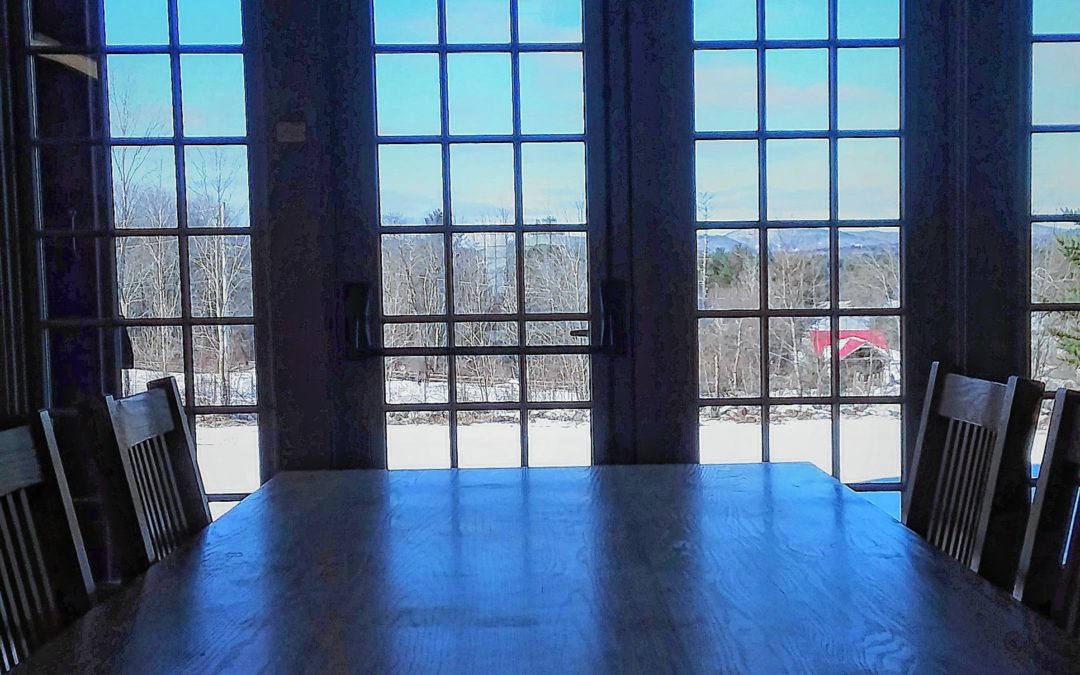By ANN SANOK
Gilmanton
Gilmanton is home to Grace Metalious, the famed author of Peyton Place. Her controversial book, which was made into a movie in the 1950s, is replete with affairs, incest and murder – all rumored to be based on the lives of Gilmanton town folks. You can find more about this community’s history and current happenings when you visit either the unique Gilmanton Year-Round Library (1396 N.H. Route 140) or the intriguing Corner Library (509 Province Road) in the town center.
Cobbler’s Delight:
Gilmanton’s Corner Library
Don’t let this tiny building’s rather unremarkable façade deter you from stepping inside. Open the six-paneled curved wooden door and you can sense the presence of its prior occupants – a hatter’s shop, printing office and most notably it was the workplace of cobbler Ira Pennock. Opened in 1912, the library is much as it was over 100 years ago. Just two small rooms lined with bookshelves under a wood-beamed ceiling, this cheerful, cozy library is a true find!
Masterpiece Barn:
Gilmanton Year-Round Library
Set in a picturesque, open field, the preservation of this antique, weathered barn is tribute to libraries everywhere and to New England’s rural, architectural history. Inside the Gilmanton’s Year-Round Library you will find a soaring ceiling crisscrossed by thick, hand-hewn timber beams, rows of paned windows and a loft surrounded by wrought-iron railings. You can view the full span of this light-filled library, with a pleasing geometry of wood and books intersecting a tall vista of space.
Pittsfield
Best Wife Inspires a Library:
Josiah Carpenter Library
The Josiah Carpenter Library
(41 Main St.) is just 15 breezy miles northeast of Concord. This compact, red brick Neoclassic building was donated to the town by Josiah and Georgiana Carpenter. Built in 1901, this library was designed by architect William M. Butterfield, a prominent New Hampshire architect during the mid-1880s until about 1910.
Located on Pittsfield’s Main Street, the Josiah Carpenter Library is a key stop on Pittsfield’s Historic Trail, a walking route that highlights this former mill town’s significant 19th-century architectural and community history.
You can pick up a trail guide inside the library and enjoy the 1½-mile walk through this intriguing old mill town.
This small, welcoming library has many unique and historic features, including quartered oak paneling, brass doorknobs and a fireproof room to protect the books – now used as a children’s room. The stately granite steps out front were hauled up from Concord, and the ornamental pilaster columns on the exterior were crafted from Indiana sandstone.
The library’s dedication in 1901 was part of the town’s Home Day Celebration that included many decorations throughout the community, a snazzy parade and lofty speeches by many town officials. On that day, Josiah Carpenter took the podium before a crowd of town folk and offered a simple sweet reason for his generous donation to the town of Pittsfield: “I passed 20 wonderful years here and above all found the best wife a man could ever wish for.”
So certainly Georgina Carpenter is deserving of equal gratitude for this lovely gift of knowledge and architecture.
Hopkinton
Farmland Beauty:
Hopkinton Town Library
Like the rising phoenix, this impressive modern library has come back to life after incurring substantial damage when struck by lightning in 2018. This unique, shingled, 10,000-square-foot structure, designed by SMP Architects in Concord, was inspired in part by Shelburne Farms in Vermont.
Built in 1998, the Hopkinton Town Library (61 Houston Dr., Contoocook) is beautifully situated in a bucolic open space with a broad view of former farmland, now a mixed use of lawns and sports fields. Adjacent to a stunning Victorian barn, the library is graced by tiered levels of stone walls and gardens. Be sure to check out the unique weather vane atop the library featuring a quill pen and a book!
Inside, the cupola allows in streams of light to naturally illuminate the interior. There is an inviting granite fireplace, study rooms and even a small café. Bonus features of this building are dual porches in the rear overlooking the sports fields. You won’t be able to resist taking a seat in one of many wooden Adirondack chairs and admiring the view!
Warner
From Baking to Books:
Pillsbury Free Public Library
This charming slate-roofed, brick and granite library at 18E Main St. in the funky little town of Warner, less than 30 minutes from Concord, has a surprising connection to the famed Pillsbury Flour Company in Minnesota.
George A. Pillsbury, the father of Charles, who started the company, lived in Henniker for many years. In 1890, he donated $10,000 to the town of Warner to build a library. Pillsbury was insistent that the building be as fire-proof as possible, utilizing iron floor beams to support the stone and brick structure. Unique stained-glass transoms illuminate the small reading room.
The library opened in February 1892 with about 4,500 volumes and was quite the event of the winter season. People rode in horse-drawn sleighs and stood in line on opening day. The process for checking out a book was much different from today, as patrons had to consult a master list of books and then indicate their selection to the librarian who was the sole person allowed to retrieve books from the stacks.
At the dedication ceremonies on Oct. 2, 1891, George Pillsbury said in his speech it was his wish that, “All the people of Warner, young and old, rich and poor alike, may realize therefrom all the benefits that a free public library can give.”
A nicely done addition was added in 1994. The library now contains more than 25,000 books, music CDs, videos, newspapers and magazines. There is a very active children’s room, a meeting room, computer-assisted book search service, and computers (and wi-fi) for public use.
This cool New England town boasts two covered bridges, a river and even a mountain.
Henniker
A ‘Temple Reared by Human Hands’:
Tucker Free Library
Such were the words presented at the dedication of Henniker’s Tucker Free Library in 1904.
Located at 31 Western Ave., along at the southern end of the scenic Currier and Ives Byway (Route 202), the Tucker Free Library, was one of the most impressive buildings at the time it was built, and it retains that distinction today in this appealing college town.
The initial funds for the building were provided by the will of George Tucker, who was born in Henniker in 1836. Never married and having no living relatives upon his death, he left money for the creation of a library. Another resident, Henry M. Emerson, donated the land. Architect Henry M. Francis was commissioned for the job. Francis’s design closely reflects the Romanesque style of Boston architect Henry Hobson Richardson, who designed the Thomas Crane Public Library in Quincy, Mass. Francis designed 15 libraries in Massachusetts, New Hampshire and Vermont, all notable for their deeply recessed doorways and ornate stone arches.
The building rests on a granite foundation and faced with red brick walls, both edged with rusticated stone juxtaposed against horizontal blocks of smooth stone, all under a tidy hip roof. The original globe-topped lampposts were reinstalled a few years ago after being discovered in the library attic.
The architectural elements are subtle: a Greek key motif in the tiled floor at the entrance area matches the design embedded in the exterior, 11-foot-high ornate ionic columns grace the main hall and above, an intricate, detailed ceiling. Many original chairs and tables remain in use in the spacious reading room, which is filled with historic photographs and artifacts documenting Henniker’s rich history.
Hillsborough
Deal of a Lifetime:
Fuller Public Library
From Henniker, you can wind your way to the quiet town of Hillsborough, known as the birth place of President Franklin Pierce, and home to a much lesser-known, but indisputably hidden gem, the Fuller Public Library. Located at 29 School Street, this amazing library occupies a remarkable public space that was once the grand home of New Hampshire Gov. John B. Smith. The Smith family donated the building to the town in 1926 for the cost of one dollar.
The original building was constructed in 1866 with Smith taking ownership of the property in about 1880. Smith embarked on a massive renovation of the residence, at the cost of $100,000 – an extremely hefty sum in those days – to create a highly elegant and artistically influenced home.
The stunning interior is remarkably preserved and ideally re-purposed as a community space for learning and contemplation. The floor near the main entrance is a unique mosaic of tiles. Once covered in red leather, the interior walls are now painted a soft white, beautifully emphasizing the ornate quartered oak arched moldings and the many artistic touches.
Look up and one is reminded of the churches of Europe; intricate paintings decorate the upper walls and ceilings. Child angels watch from above, surrounded by a swirl of garden flowers and bounties of fruit. An original tapestry of George Washington hangs above the impressive oak staircase, as does an ornate chandelier.
The Fuller Library has preserved the openness and grand nature of the first floor, wisely utilizing the walls in the main rooms for shelving other discreetly situated bookcases in order to showcase each room’s impressive features. u


 View Print Edition
View Print Edition
Her writing inspires me to visit all sites.